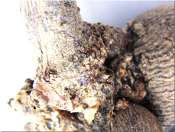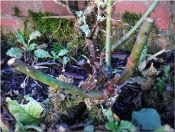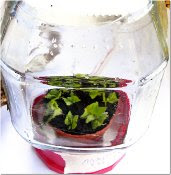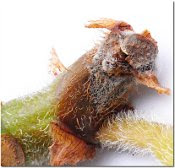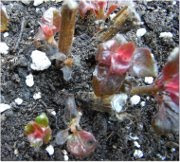This is the $64k question. It's a situation where growing suddenly becomes an art: where something which sounds easy to work out on paper suddenly becomes incredibly complex.
Just in case you don't want to follow the story (and who can blame you?), here's my advice: KEEP THEM AS DRY AS YOU CAN (i.e. don't water them unless you really have to). If you are unsure, stick in a thermometer and check things out.
CONDUCTION, CONVECTION AND RADIATION
We are back to
conduction, convection and radiation again - with something called HEAT CAPACITY thrown in for good measure.
Heat Capacity
This is the amount of heat required to raise the temperature of an object by a given amount. Both water and bricks have high heat capacities. This means they are slow to warm up (think of coming home to find the heating has been off for a few days and how much heat it takes to get back to normal). Whilst this isn't good when planting in spring, it is fantastic in winter, since it means pots of wet soil/compost kept close to the house are much slower to freeze than they would otherwise be (think of standing next to a storage heater). So we just water pots and keep them close to the house? If only it were that simple.
WET COMPOST PRODUCES TURGID CELLS
Much depends upon whether the frost is severe enough - either through a large drop in temperature, or through the length of exposure during a prolonged cold spell - to cause the compost to freeze solid. Should this be the case, we can be in trouble. We
saw recently that plant cells are damaged by the formation of ice crystals within turgid (full of fluid) cells, since the sudden expansion can rupture the cell walls. This is the problem with watering the compost; there is no way to prevent this water entering the plant and producing these turgid cells.
DRY COMPOST PRODUCES FLACCID CELLS
However, the flaccid cells produced in drier compost not only have more concentrated sap (which freezes at a lower temperature), but can also accommodate any ice crystals which do manage to form. This seems like a better situation. But things are complicated by the fact that plants, even in damp compost, can produce this situation by hardening themselves, as we saw elsewhere.
CONDUCTION AND CONVECTION
Sandy soils can be a problem for two reasons:
They are good heat conductors, so easily bring heat to the surface from down below.
They have large pores through which air currents can easily pass and remove heat by convection.
These soils tend to be too hot in summer and too cold in winter. The problem is made worse by the fact they cannot hold much water.
RADIATION
Lighter soils tend to be cooler, since they reflect the sun's heat back in summer and are reluctant to reflect valuable soil heat in winter. These effects are lessened if the soil is wetted, since it inevitably becomes darker and therefore a better radiator.
EFFECT OF MULCHING
Mulching can provide a solution. I like to apply dry peat or potting compost to pots and delicate plants just before a severe frost. This provides an insulating layer and helps considerably. Garden compost has a similar effect. If applied at this time, the lighter frosts will have had a chance to kill off some of the pests which might be in the surface layers. If using potting compost, take care not to use it around lime-hating plants (calcifuges).
 You will often hear it said that it pays to remove buds from cuttings because they take up energy which could otherwise be used for growth. Whilst this is undoubtedly true, it is not my main reason for dis-budding.
You will often hear it said that it pays to remove buds from cuttings because they take up energy which could otherwise be used for growth. Whilst this is undoubtedly true, it is not my main reason for dis-budding.





